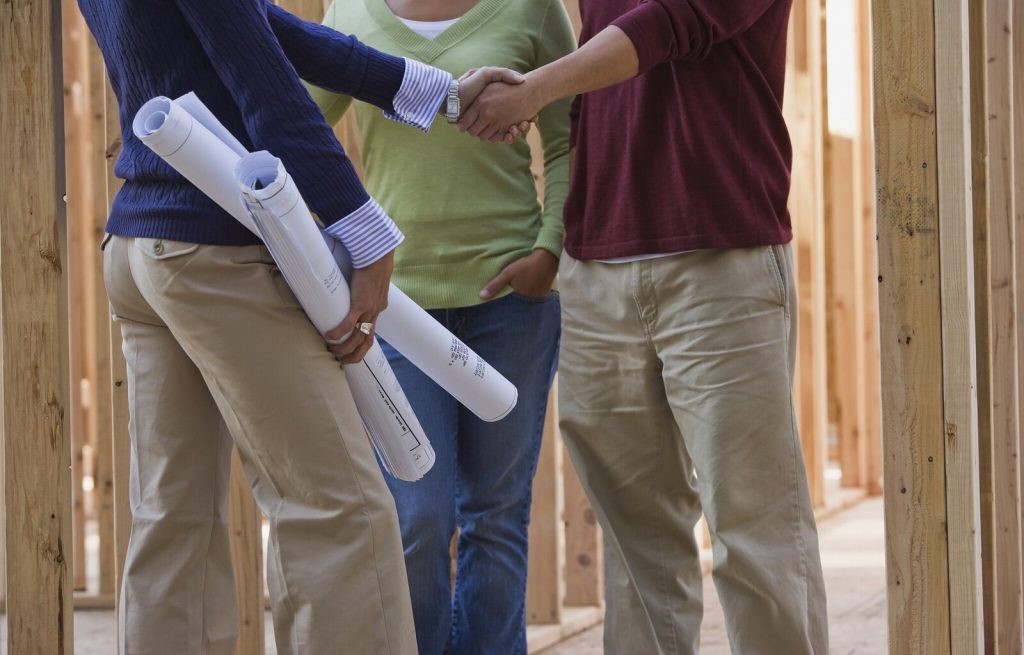Building a new home can be a fun and exciting opportunity, whether it is on land you own or in a beautiful new home community, there are quite a few advantages to building (or buying) a new construction home.
- What is a New Home Construction Loan?
- What Does a New Home Construction Loan Cover?
- Differences: Construction Loans vs. Traditional Mortgage
- How do New Home Construction Loans Work?
- What are the Requirements for a Construction Loan?
- Types of Home Construction Loans
- Government-Assisted Home Construction Loans
- How to Get a New Home Construction Loan
- Is a New Home Construction Loan Right For You?
- Home Construction Loan FAQs
That said, building a new home is quite a different experience compared to purchasing a resale home – the adventure of building your new home comes with variety of nuances, challenges, opportunities, decisions, and complexities – specific to building a home – that the average home buyer has never had to face.
Understanding your available loans and financing options, how they work, and what works well for you is a critical step to realizing your new home dream.
So, if you’re thinking about building a new home or buying new construction, you should know that there are specific home construction loans and financing options available to help you do just that – in fact, there are a lot of loans and options for that!
What is a New Home Construction Loan?
A new home construction loan is a specialized short-term loan that allows you to borrow the money you need to cover the cost of building a —
— new home or provide you with financing to fund a home construction project or renovation.
While intended Home construction loans are intended to cover the costs of the building process, they aren’t limited to just the building materials or labor – construction loans are specifically designed to cover the entirety or actual cost of, designing, planning, building, constructing, or renovating a residential property.
What Does a New Home Construction Loan Cover?
While home construction loans are designed around your specific needs and circumstances, typical costs you can expect a construction loan to cover include things like:
- Planning, Drafting & Design
- Land Buying or Cost of The Land
- Contractors & Labor
- Contingency Reserves
- Building Materials
- Services
- Permits & Inspections
- Appliances
- Landscaping Labor & Materials
Differences: Construction Loans vs. Traditional Mortgage
Although the two share similarities, a home construction loan is a very different type of loan than a traditional mortgage.
While both types of loans can afford you a home, a new home construction loan is a specialized type of financing that, depending on the type of loan or lender, can optionally be converted into a traditional mortgage – and so there are a number of key differences and caveats to be aware of:
- Terms & Payments
- Interest Rates & Down Payment
- Fund Access & Distribution
- Inspections, Appraisers & Authorization
1. Terms & Payments
Your average traditional mortgage has repayment terms of around 15 to 30 years, making it a long-term loan you pay over time – on the other hand, your average home construction loan is short-term loan with repayment terms of around 1 to 2 years – being designed to only last as long as it takes for you to complete construction on your home.
With construction loans, you initially pay interest on only the funds you have “drawn,” however, most construction loans must either be re-paid in full or converted into a traditional mortgage by the end of the projected building period. This often means the length of time you have before you must repay a construction loan is much, much shorter.
While a traditional mortgage gives you a lump sum, construction loans have “draw” periods – during this “draw” period, borrowers are usually only required to make interest payments on their home construction loan – as opposed to a traditional mortgage, where both interest payments and payments on the principal begin right away.
If you decide or plan to convert your construction loan into a traditional mortgage, it is after conversion that you would be required to start making payments on both interest and the principal.
While paying interest only can be a great perk in the beginning, keep in mind that — as with other types of interest-only loans — you will still owe the same amount of money at the end of the day, even if minimum payment amounts are lower at first.
2. Interest Rates & Down Payment
Construction loans are often viewed as “risky” by mortgage lenders as they don’t have something that already exists (like an already constructed home) to be used as collateral – because of this, home construction loans generally have a higher interest rate than a long-term traditional mortgage on a resale or existing home.
Additionally, home construction loan rates are almost always variable, meaning the rates may go up and down with the market based on the Federal Reserve Rate.
Home construction loans may require higher minimum down payment – while some lenders accept mortgage down payments as low as 3% (or even 0%, as we’ll see later), you can expect your average home construction loan to require a down payment of at least 10% of the project total, and even 20%-30% down payments are not uncommon.
3. Fund Access & Distribution
When it comes to a construction loan, the way you access funds works very differently, as opposed to being paid out to you the borrower as a lump sum (like a traditional mortgage), construction loans use installments and “draws” that are paid out to contractors directly as construction is progresses.
These draws are often linked to set milestones in a building project — for instance, once the foundation is laid, or the roofing is installed — or once the project hits certain percentages of completion.
“Draws” are coined as such because you are “drawing” on the loan to pay for construction as it moves forward.
4. Inspections, Appraisers & Authorizations
As opposed to the borrower managing payments and the organization of loan finances, lenders work with project appraisers or inspectors to assess construction progress and authorize payment at different stages of construction.
These inspectors or appraisers conduct multiple inspections throughout construction, and it is only through their approval that funds or payments are be made.
How do New Home Construction Loans Work?

New home construction loans work in three stages:
- Planning & Application
- Construction
- Completion
Planning & Loan Application:
During planning, the borrower gathers and submits all financials, construction timelines, and plans to a lender for approval.
The planning, application, and approval process for a new home construction loan is far more complex than applying for a traditional mortgage – and as you’ll see the requirements for approval can be much higher.
Construction:
Once a borrower is approved, payment or “draws” for construction can begin – when a home construction loan is approved, the lender uses an appraiser or inspector to assess construction progress and authorize the disbursement of funds based on construction milestones, stages, or percentage of completion.
Home Completion:
Prior to completion, the borrower typically only pays interest, once the build period is over and the home complete, the principal becomes due in full – it is at this point that the borrower can either pay the full construction loan principal or, more typically, convert the home construction loan into a traditional mortgage, and from that point on, repaying interest and the principal just like they would after buying a resale home.
What are the Requirements for a Construction Loan?
When applying for a construction loan, you can expect to be asked for all the typical mortgage application materials – like your credit score, income, and proof of employment – but you’ll also have additional requirements to negotiate.
Some of the most common lender requirements are:
- The planned home must be a one-unit, single-family, detached residence – so no condos, townhomes, or multifamily properties.
- It must also be an owner-occupied primary or secondary residence.
- The borrower will need to contract a licensed and insured builder, with a strong record of success; lenders will view your choice of builder closely and will likely want to see your construction contract with them.
- You’ll need to provide a complete plan, or “blue book,” of the construction process – everything from floor plans to construction materials to schedules. These will need to be checked against any local building codes.
Construction loans aren’t secured by a fully built home, so lenders have stricter guidelines when assessing your financial situation – often wanting to see plans, project timelines, and estimated costs.
Types of Home Construction Loans
Your choice of home construction loan can largely depend on multiple factors such as: the specific project, your credit history, or even your lender – and being that construction loans are specialized loans, your choice of lender is an important decisions and it’s often recommended to go with lenders who are firmly experienced in handling home construction loans – and – with so many different loans available -can help you find the right loan for you.
Government-Assisted Home Construction Loans
How to Get a New Home Construction Loan
Getting a new home construction loan is a multi-step and sometimes lengthy process – and knowing the basics of what you need and how those steps play out can be a big help in preparing you for that process:
1. Select a Home Builder
Before you get too deep in the weeds of a construction loan application, it’s important to choose the right builder for your project. And to do that, you’ll need to think carefully about your priorities. Is it important to you that the builder has strong energy efficiency records? What kinds of homes do they need to build, and where?
Online directories from organizations like the National Association of Home Builders (NAHB) is a great place to start, but be careful to check out multiple sources, including any friends, family members, or neighbors with personal experience in having a home built.
2. Plan Your Construction Timeline and Project Budget
Work with your builder to get an idea of how much your project will cost, and how long you want it to take.
It’s essential to have at least a rough idea of these questions in order to know how big of a loan you’ll need and what kinds of repayment terms, in order to (spoiler alert) pick the right lender.
3. Choose a Home Construction Loan Lender
As many kinds of mortgages as there are out there, there are even more lenders. As with your search for a builder, it’s important to check out multiple sources, and there’s an abundance of online resources to help you get started.
You’ll also need to get your finances in order and be sure of how much money you need, what kind of monthly payments you can realistically make, and how long of a repayment period works for you. These are also questions to consider when deciding which kind of construction loan to apply for.
4. Get Preapproved for a Home Construction Loan
Of course, it’s not enough to have your dream lender picked out. You also need to work with them to make sure that you actually can get approved, and for what amount, in case that affects your budget. You’ll need all the records typically required for a mortgage application, including credit history, bank statements, pay stubs, tax records, and proof of funds.
Keep in mind that this is not a perfectly linear process, and every step might retroactively affect those that came before: For instance, if you get preapproved for a different amount than you expected (whether higher or lower), that may well affect your budget, and your timeline, and so forth.
You’ll find that lots of decisions may need to be made and remade as you get all your ducks in a row, but that’s nothing to worry about; it’s all part of the process.
Is a New Home Construction Loan Right For You?

It depends, if you’re set on building your home from start to finish, a construction loan is probably the route you need to go – if you are looking for a new construction home but aren’t sure you want to go through the building or construction loan process, there are sometimes available quick-move in or move-in ready homes – that is – new construction homes that are either fully built or very close to completion – these homes are most often treated the same way as a resale home, using a traditional mortgage to finance the home purchase.
As new home builders, K. Hovnanian Homes is well versed in the issues customers face when wanting to build or buy a new construction home – understanding the process and working with a lender who understands it are key to financing a successful home build – especially if it’s your first time building or buying a new construction home.
So while this all might seem like a lot to keep track of, the important thing to remember is that when it comes to homeownership, it’s always best to know and take into consideration all your options.
Home Construction Loan FAQs
At K. Hovnanian Homes, with meticulous attention to detail and excellent customer service, we take pride in building beautiful new construction homes and communities across the nations – with a wide offering of homes and designs, you can be sure to find a new home to fit both your lifestyle and your budget.
Want to learn more? Contact Us Today or use our home search to Find a K. Hovnanian Community near you!
Last Updated on March 12, 2024
